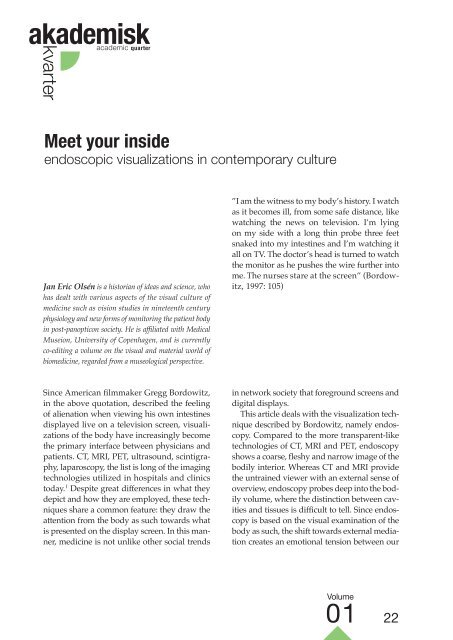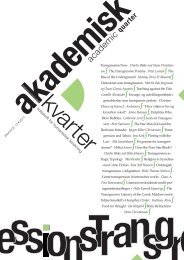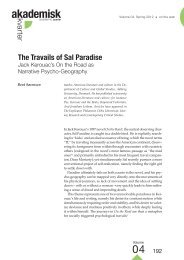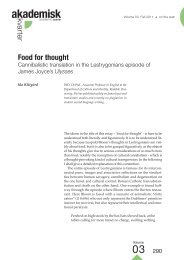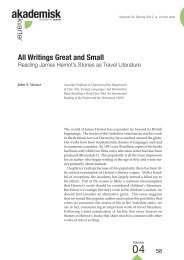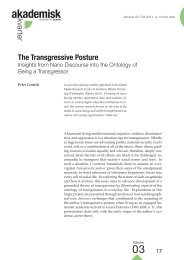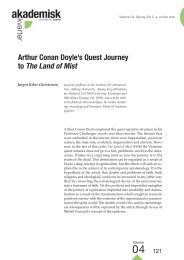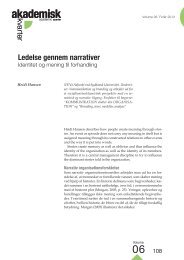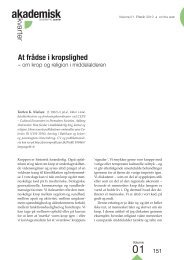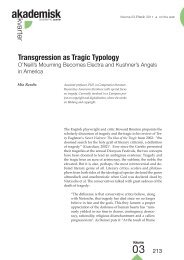Academic Quarter - Akademisk kvarter
Academic Quarter - Akademisk kvarter
Academic Quarter - Akademisk kvarter
You also want an ePaper? Increase the reach of your titles
YUMPU automatically turns print PDFs into web optimized ePapers that Google loves.
akademiskacademic quarter<strong>kvarter</strong>Meet your insideendoscopic visualizations in contemporary cultureJan Eric Olsén is a historian of ideas and science, whohas dealt with various aspects of the visual culture ofmedicine such as vision studies in nineteenth centuryphysiology and new forms of monitoring the patient bodyin post-panopticon society. He is affiliated with MedicalMuseion, University of Copenhagen, and is currentlyco-editing a volume on the visual and material world ofbiomedicine, regarded from a museological perspective.”I am the witness to my body’s history. I watchas it becomes ill, from some safe distance, likewatching the news on television. I’m lyingon my side with a long thin probe three feetsnaked into my intestines and I’m watching itall on TV. The doctor’s head is turned to watchthe monitor as he pushes the wire further intome. The nurses stare at the screen” (Bordowitz,1997: 105)Since American filmmaker Gregg Bordowitz,in the above quotation, described the feelingof alienation when viewing his own intestinesdisplayed live on a television screen, visualizationsof the body have increasingly becomethe primary interface between physicians andpatients. CT, MRI, PET, ultrasound, scintigraphy,laparoscopy, the list is long of the imagingtechnologies utilized in hospitals and clinicstoday. 1 Despite great differences in what theydepict and how they are employed, these techniquesshare a common feature: they draw theattention from the body as such towards whatis presented on the display screen. In this manner,medicine is not unlike other social trendsin network society that foreground screens anddigital displays.This article deals with the visualization techniquedescribed by Bordowitz, namely endoscopy.Compared to the more transparent-liketechnologies of CT, MRI and PET, endoscopyshows a coarse, fleshy and narrow image of thebodily interior. Whereas CT and MRI providethe untrained viewer with an external sense ofoverview, endoscopy probes deep into the bodilyvolume, where the distinction between cavitiesand tissues is difficult to tell. Since endoscopyis based on the visual examination of thebody as such, the shift towards external mediationcreates an emotional tension between ourVolume01 22
akademiskacademic quarter<strong>kvarter</strong>Meet your insideJan Eric Olsénembodied sense of corporeal interiority andthe live images of soft tissues projected ontoTV monitors and computer screens. Drawingon the work of visual cultural scholarssuch as José van Dijck and Tom Gunning (vanDijck, 2005; Gunning; 2003), I argue that thetechnological visualization of the inner fleshyields an estranged relation between what wesee on the screen and our unseen insides. Theeffect of different endoscopic technologies onour perception of the inner body is illustratedwith examples from clinical medicine and performanceart.Watching your guts on TVBordowitz’ wry account of a routine colonoscopyas performed in the 1990s, points outseveral noteworthy things. Firstly, it gives avisceral picture of the invasive nature of endoscopy.Compared to X-rays, which permeate thebody in a subtle manner, endoscopic visualizationshinge on the physical contact betweeninstrument and body. Most of us are familiarwith the meaning of a colonoscopy. We shiverat the thought of having long probes insertedthrough our rectum and tend to find examinationsof the gastrointestinal tract awkward. Secondly,the passage provides a telling exampleof how medical visualizations gradually haveredirected the attention of physicians from thebody of the patient to monitors and screens. Asthe term indicates, endoscopy (from the Greekendo = inside and scope = look) is the medicalpractice of peering into the body for diagnosticpurposes. Although attempts of inspecting thebodily cavities with the aid of mirrors and lightreflectors can be traced back to antiquity, it wasfirst during the late nineteenth-century that endoscopydeveloped into a clinical method withits own proper instruments (Reuter, Reuter &Engel, 1999: 163). Contrary to the examinationdescribed by Bordowitz, physicians duringthis period would use their instruments to lookinto the body itself, regardless of if it was theeyes, the larynx, the colon or the bladder thatwas the object of the examination. Bordowitzlaconic description of the doctor and nursesstaring at the screen, does not only illustratea shift in diagnostic technology. It says somethingimplicit about the relation between bodyand representation in contemporary medicine.Thirdly, by drawing a parallel between TV andlive videoscopic images of the bodily interior,Bordowitz touches upon a crucial aspect ofmedical visualizations, their intrinsic relationto popular culture and the way in which mediaforms the gaze. The key words here are “safedistance”. The gaze that watches the newsfrom a safe distance in the living room safeguardsthe patient as his or her inner flesh appearsdistantly on the hospital screen. Movedinto the clinic, the television set creates an effectof alienation vis-à-vis the body. Althoughliterally wired to the monitor, the patient looksat the images as if they didn’t refer to him orher: “I am not the image of my intestine”, saysBordowitz (Bordowitz, 1997: 105).Cable transmitted video colonoscopy is interestingbecause it marks the shift in endoscopicattention from inward peering to outwardobservation. What was once only accessibleto the solo gaze of the physician is nowturned inside out and rendered visible to thepatient as well. It goes without saying that thiskind of joint looking differs widely from theenclosed gaze of prior days. Advocates of videoendoscopylike to think that the images fur-Volume01 23
akademiskacademic quarter<strong>kvarter</strong>Meet your insideJan Eric Olsénmaps make it possible to orientate oneself insidethe video. This form of endoscopic viewinghas less to do with vision in the classic opticalmanner than with running the patient dataon an appropriate computer. Vivian Sobchackhas pointed out that technology does not onlyenable us to see images in different ways butalso to see technologically (Sobchack, 2004:139). Viewing an endoscopic film on the computerscreen after the patient has handed backthe recorder implies a different approach tobodily representation than if the viewing takesplace life meanwhile the patient is being examined.In her book The Virtual Window. From Albertito Microsoft (2006), Anne Friedberg pointsout the great importance that the window hasplayed for the formation of visual knowledgein Western culture. From Alberti’s treatise onperspective to today’s virtual computer environments,the window has served as a modelto structure the relation between viewer andimage. We have only to think of the metaphoricuse of “windows” in the personal computer, tosee just how firmly rooted in our pictorial consciousnessthe notion of looking at an image asif we saw it through a window is (Friedberg,2006: 220). Even today’s digital interface withits panoply of images still retains the idea ofthe window as an overall guiding principle forvisual representation. Following Friedbeg, wecould describe the development of endoscopicvisualization as a movement from the body aswindow to the window as body, from a formof looking that utilized the natural openingsof the body to a form of looking for which thewindow has become a stand-in for the body.Displayed on the computer screen, the imagesof bodily cavities can be manipulated withgreater ease than clinical examinations wherethe endoscope must be moved carefully insidethe body. This is a pivotal aspect of the shiftfrom television screen to computer display. Itunderscores the difference between looking atthe body as a broadcasted event and looking atthe body as an interactive program.Whereas Gregg Bordowitz in the above examplesaw his own video endoscopy throughthe lens of a natural born TV viewer, patientstoday are probably more inclined to comparedigital images of their inner flesh to other manifestationsof computer culture such as simulations,film clips in Quick Time, fly-through animationsor even video games. Physicians havealready adapted to the new media landscape.The term fly-through for instance, commonlyused in architecture where computer generated3D-models have been around for some timenow, has found a growing application in medicineand biomolecular research (Turkle, 2009:63). Physicians who work with virtual representationsof the body, i.e. digital models derivedfrom CT-scans, talk about fly-through examinationsof the inner anatomy. The referenceto flying appeared already 1994 in the title ofan article on virtual endoscopy (Parkins, 1994:1046). Two years later, the computer scientistArie Kaufman, boosted the new technique inan interview, stating that it allowed physiciansto “fly through” the images of the colon and“search for bumps and other abnormalities”. 3Likewise, the biophysicist Richard A. Robbcharacterized virtual endoscopy as an “immersive”technique, which allows the “endoscopistto simultaneously visualize the anatomy andmanipulate the viewing orientation in a realisticway” (Robb, 2000: 135). To the general public,anatomical fly-throughs are perhaps mostlyVolume01 25
akademiskacademic quarter<strong>kvarter</strong>Meet your insideJan Eric Olsénassociated with the Visible Human, whose softwareatlas offers the non-medical expert flythroughtours of the whole body. 4To what extent the digitization of the endoscopicbody will bring about a different perceptionof our inner flesh is difficult to say. If thepill camera promises a non-invasive mode ofexamination from the patient’s point of view, itcertainly provides physicians with an immersivetechnique for visual scrutiny, a method forreframing the two-dimensional view throughthe endoscope within the multimedia windowof the computer. The question is what kind ofvisual landscape that is emerging from insidethe various software applications, and whatsort of gaze that is being normalized in front ofthe screen.Gastrointestinal voyageAlthough linked to the TV monitor via thelong endoscopic wire, Gregg Bordowitz wasreluctant to identifying himself with what hesaw. As far as he was concerned, the images ofpinkish intestines could be showing just aboutany distant body broadcasted on TV; “I’ve seenexploratory images of the insides of bodies onTV medical programs. I am prepared for thisknowledge. Television prepares us” (Bordowitz,1997: 105). In the case of the pill camera itis information technology, the Internet, downloadabledata and wireless networks that ispreparing us for new images of our insides, infact an old motif, that has been reframed due tochanges in media infrastructure. Compared tovideo endoscopy, the pill camera would seemto entail an even more alien sight of our bodilyinterior. Not only that the images in themselvesare stark to see. The whole procedure of havinga small camera take pictures of our stomachand bowels while we go about our daily routinesis pretty extreme. Like spying on oneselfand handing the secret message over on theportable recorder. What is it that I don’t knowabout my body that this automatic eye can reveal?And do these images really contribute toour understanding of our corporeal selves, assome physicians like to think, or do they rathermake us feel estranged in relation to our embodiedsensibility?These questions are explicitly dealt with inthe work of London based artist Phillip Warnell.Using himself as experimental source, Warnellexplores the relation between the body as anunknown inside and the means by which wetry to unravel it. The Girl with X-ray Eyes (2007)(title of film and book), for instance, deals withthe phenomenon of extra-visual power. In thefilm, Warnell lets Natasha Demkin, a Russianmedical student, claimed to have x-ray vision,scan his body with her bare eyes. Typical forWarnell’s performances and artworks is themixture of science and popular culture, rationalconceptions and irrational beliefs, new mediaand old media. 5 The different references areused to situate the performance and show hownotions of the body are created in the intersectionbetween high culture and popular culture.The theme of the transparent body, whichwas central to The Girl with X-ray Eyes, is alsoaddressed in the confluence event Endo/Ecto,performed at ICA in London and MedicalMusieon, Copenhagen. 6 Contrary to NatashaDemkin’s innate X-ray eyes, Endo/Ecto revolvesaround a capsule endoscopic visualizationof Warnell’s inside. 7 It is medical technologyand not supernatural abilities that renders theopaque body transparent here. The perform-Volume01 26
akademiskacademic quarter<strong>kvarter</strong>Meet your insideJan Eric Olsénance in short stages the swallowing of a pillcamera, the transmission of the images to acomputer and the projection of the endoscopicimages on a large screen along with old SFmoviessuch as Fantastic Voyage and The Manwith the X-ray Eyes (1963). In Copenhagen, theperformance also featured a screening of JamesWilliamsons hilarious trick-film The Big Swallow(1901), which shows how the cameraman,shooting from the same angle as the audience,is engulfed by the sole character in the film.The London performance on the other hand,included a demonstration of marine bioluminescence.By presenting innovative technologyalongside old-fashioned movies and luminousmarine organisms, Warnell draws our attentionto the cultural construction of transparency.Compared to bioluminescent organismswhose green phosphoric radiation illuminatesthe deep sea, endoscopic transparency isachieved through a series of mediated imagesthat derive from compact and solid technologysuch as the pill camera and the software thatmakes the gastrointestinal images visible onthe computer screen. Only in converted form,disengaged from the inside it points back to,does the pill camera show us our transparentflesh.Obviously, the different technological devicesused to visualize the inner body, is not theonly thing that differs Bordowitz’ descriptionfrom Warnell’s performance. Set in a hospitalcontext with illness as an unyielding factor,Bordowitz experience of endoscopic examinationis as private as Warnell’s gastrointestinalvoyage is public. It’s doubtful whether Warnellhad been able to perform Endo/Ecto had it notbeen for the wireless and automatic applicationof capsule endoscopy. With José van Dijckwe could say that the pill camera takes the notionof a permeable body that can be viewedsmoothly from within, even further than fibreoptic video endoscopy (van Dijck, 2005: 66). Inthis respect, the endoscopic gaze that van Dijcktraces through the shifting media landscape ofthe twentieth-century has converged with thescanning technologies of today. Both seem to offeran image of the body as a porous entity thatwe no longer have to cut open in order to see.As van Dijck rightly points out, medical visualizationsand media technologies have alwaysbeen inextricably interweaved with one another,which is to say that the public spectacle is aningrained element of the medical gaze. Today’subiquitous information networks have hardlymade medical visualizations less spectacular.We have only to consider the spread of the VisibleHuman Project on the Internet, to recognizethe persistence of this scopic quality in medicine.Whether increased visibility necessarilyleads to a familiarization of the inner body, asvan Dijck argues, is however disputable (vanDijck, 2005: 69). It may be that the proliferationof medical visualizations in information societyhas yielded an understanding of the bodyas perfectly transparent and accessible. Yet,since this transparency and porosity is intrinsicallytechnological, the perception of the innerbody is caught up in the ever-changing frameof the visual apparatus; lenses, scopes, fibreoptics, video monitors, TV screens, computerwindows etc.According to Tom Gunning, technologicalinnovations incite feelings of astonishment andwonder that tend to fade away shortly after thenew technology becomes routine. Gunningalso notes that this feeling of astonishment isnot merely caused by a sense of unfamiliarityVolume01 27
akademiskacademic quarter<strong>kvarter</strong>Meet your insideJan Eric Olsénvis-à-vis the new technological device, it hasalso to do with a utopian dimension in technologythat envisions a future fundamentallytransformed by the new device (Gunning, 2004:56). Once embedded in our habits, technologiesturn ordinary, and the utopian dimension sinksinto oblivion. However, as briefly remarked byGunning, when least expected, the forgottenfuture can suddenly reappear with uncannyeffect amid the customs of everyday life (Gunning,2004: 56). Applied to endoscopy, the viewthat technology passes from being somethingwondrous to being just another ordinary practice,can help us better describe the transitionthat the endoscopic image has undergone inthe above examples.If we take the case of Bordowitz, the picturegiven of endoscopy here is one of ennui. Thefact that the visualization of the inner body,is carried out as a diagnostic examination, accountsfor the gloomy tone. Medical images arenot always easy to tell apart and digital mediahas certainly not made it easer to discern thedifference between visualizations of illnessesand of health. Nevertheless, if we focus on themeans by which the inside of Bordowitz is visualized,we notice how the whole experience oflooking at the endoscopic images is associatedwith watching TV. It is television that chargesendoscopy with psychological meaning. Endlessevenings in front of the TV, had preparedBordowitz for his endoscopic examination. Ahighly familiarized media form enables himto cope with his feelings of discomfort. On theother hand, it is precisely this familiar gazethat renders the images of Bordowitz inside estranged.Displaced from its domestic context,the television screen introduces a well-knownelement among the specialized equipment ofthe clinic. But, because the images displayedon the screen show us what we normally onlyexperience through visceral sensation, thebody on TV is experienced as something utterlystrange.Strange encounterIf Bordowitz viewed his inside through theframe of a standardized medium, namely television,the technology that Phillip Warnell employedin his performance, is still in the processof rapid expansion. Wireless communication,miniaturized technology and portable devicesmay not have released us from the prison ofthe screen as Lev Manovich so aptly put it, butthey definitely have made our screen habitsless restricted to spatial confinement (Manovich,2001: 114). These three factors are also atleast as important in Endo/Ecto as the projectionof the endoscopic images in themselves. Withoutthe actual swallowing of the pill camera,which is emphasized in the performance, wewouldn’t see the images of the bodily interiorwith the same feeling of amazement. Althoughwe’re surrounded daily by the latest productsof information communication networks, thepill camera brings out the almost inconceivablenature of these technological systems. Undoubtedly,there’s something uncanny abouta high-tech object that is designed for suchprimordial functions as intake and ingestion.However, viewed from another perspective, anendoscopic camera that covers the same routethat our daily food consumption takes can onlymake sense in a society saturated by surveillancecameras.By positioning the endoscopic visualizationin an art performance context, Warnell invitesVolume01 28
akademiskacademic quarter<strong>kvarter</strong>Meet your insideJan Eric Olsénus to reflect upon the inward body as a biologicallyintroverted and culturally traversed space.The resemblances that take place between opticaltechnology, Warnell’s sensor strapped body,the gastrointestinal images taken by the immersedcamera and the cinematic fascinationwith the corporeal inside, show that no matterhow visualized, the body retains an enigmaticquality that evades rational explanation.The more we look at it, the stranger it appears.This can be said about the optical technologyas well. 8 Once inside the body, the pill camerais out of our control. We can only sense its occurrencein the flesh via the images it transmitsto the computer, images that we see throughits point of view so to speak. Before our veryeyes, the pill camera disrupts our ordinary notionof photography as it is sucked deeper anddeeper into the bodily cavities. Somewherealong its way, the automatic eye suddenly encountersthe presence of something utterlystrange inside the stomach, the letter “S” driftingbetween the abdominal walls. What is detectedhere is simply one of the paste letters,spelling the words, Guest Host Ghost, whichWarnell swallowed minutes before the pillcamera. The paste letters add yet another linkto the various resemblances mentioned above.They underscore our understanding of the innerbody as something that oscillates betweenvisual representation – scientific, fictive or performative– and beyond representation. But theletters also bring to mind what Warnell wrotein an article about his own work, that one ofthe things he explores in his performances areaspects of bodily “intimacy and anonymity”and how these are played out in relation to thesocial configuration of bodies (Warnell, 2009:35). This is also something that lingers on in themind after having seen Endo/Ecto. How the mediatedinside, is projected anonymously on thescreen meanwhile the person it refers to looksat the peculiar scene that is taking place in hisstomach.ConclusionWith the media technological innovations ofthe late twentieth century, the view through theendoscope, which previously was observableonly to the physician’s eye, has now been madevisible to patients and even spread beyond theclinic to the public realm. This mediation of ourinside flesh entails above all two things: a redirectionof the inward gaze outwards – fromlooking into the physical body to looking atits visual representations on screens of variouskinds – and the fact that our palpable, unseenbodies, are displayed live in all their abhorrentappearance. Although the endoscopic imagesat first glance appear to be overall alike, regardlessof if we see them on TV or on a computerscreen, we view them differently dependingon the visual apparatus through which theyare conveyed. We might even say that the samecorporeal spectacle tends to transform due tothe technological apparatus that frames it andthe situation in which we find ourselves whenlooking at it. As always with spectacles, whatfirst strikes us as new and unfamiliar, eventuallyturns into something familiar when theinitial attraction fades out leaving only a routinegaze behind. However, what we tend tofind familiar can take on a strange appearancewhen we least expect it. In the case of our innerbodies, the fact that endoscopy makes themvisible by means of technological mediation, tosee what we normally only sense as embodiedVolume01 29
akademiskacademic quarter<strong>kvarter</strong>Meet your insideJan Eric Olséninteriority, is in itself an astonishing act. Seenthrough the shifting devices of visual mediation,this feeling of astonishment is nonethelessaffected in various ways, from the strangefeeling of looking at one’s inside on somethingas regular as a television screen, to the weirdsight of someone swallowing a miniature camerathat transmits images to a computer. In thissense, technological visualizations do not onlycontribute to making the inner body known tothe general public. They also present the bodyas something that we never quite completelyare familiar with.Notes1 The literature on the cultural impact of medicalimaging is immense. See here for instance IsabelleDussauge, Technomedical Visions: MagneticResonance Imaging in 1980’s Sweden, Stockholm;KTH (dissertation), 2008; Joseph Dumit, PicturingPersonhood. Brain Scans and the BiomedicalIdentitity, Princeton University Press, 2004 andBettyanne Holtzmann Kevles, Naked to the bone:medical imaging in the twentieth-century, RutgersUniversity Press, 1997.2 On the connection between the pill camera andthe Fantastic Voyage see the chapter ”EndoscopicGaze” in José van Dijck’s book The TransparentBody. A Cultural Analysis of Medical Imaging,Washington University Press: Seatle, 2005.3 For the interview with Kaufman see the followinglink: http://www.nytimes.com/1996/04/14/nyregion/from-stony-brook-anew-way-to-examine-colons-externally.html?sec=&spon=&pagewanted=all. 27-04-2010.4 The Visible Human Project stands out as a landmarkof medical and information technologicalamalgamation and a reminder that despiterefined methods, medical knowledge still relieson the density of the human corpse. On the VisibleHuman Project see Catherine Waldby, TheVisible Human Project. Informatic bodies and posthumanmedicine, Routledge, 2000.5 On Phillip Warnell’s work see Ric Allsopp’sessay Performing the Interior, http://www.freisprung.com/blog/2009/02/performing-theinterior-by-ric-allso/6 Phillip Warnell has performed Endo/Ecto twice.The first performance was at ICA, London, 10February 2006 and the second one at MedicalMuseion, Copenhagen, 13 September 2009.7 On other endoscopic artworks see Renée vande Vall’s article, “Between Battlefield and Play:Art and Aesthetics in Visual Culture”, ContemporaryAesthetics, Vol. 1, 2003, http://www.contempaesthetics.org/newvolume/pages/article.php?articleID=215,which revolves roundMona Hatoum’s endoscopic installation CorpsÉtranger from 1994.8 In a recent article, Tom Gunning speaks of the“optical uncanny” as a certain trope in fantastictales and modernistic fiction. Warnell’s use ofthe pill camera resembles the way that authorssuch as E.T.A. Hoffman, Edgar Allen Poe andEduardo Mendoza, inscribed optical instrumentsin their fantastic and visionary fiction.See Tom Gunning “Uncanny Reflections, ModernIllusions: Sighting the Modern Optical Uncanny”in Uncanny Modernity. Cultural Theories,Modern Anxieties, Jo Collins & John Jervis (eds);Hampshire, Palgrave MacMillan, 2008, 29-60.LiteratureBordowitz, Gregg, “Present Tense” in ProcessedLives. Gender and Technology in Every-Volume01 30
akademiskacademic quarter<strong>kvarter</strong>Meet your insideJan Eric Olsénday Life, Jennifer Terry & Melodie Calvert(eds), Routledge: London, 1997.Cave, R. David, “Technology Insight: currentstatus of video capsule endoscopy” inNature Clinical Practice, Gastroenterology &Hepatology, Vol. 3, No. 3, 158 – 164, 2006.van Dijck, José, The Transparent Body. A CulturalAnalysis of Medical Imaging, Universityof Washington Press: Seattle, 2005.Friedberg, Anne, The Virtual Window. FromAlberti to Microsoft, MIT Press: Cambridge,2006.Gunning, Tom, “Re-Newing Old Technologies:Astonishment, Second Nature, andthe Uncanny in Technology from the PreviousTurn-of-the-Century” in RethinkingMedia Change. The Aesthetics of Transition,David Thorburn & Henry Jenkins (eds),MIT Press: Cambridge, 2003.Koti, Harubumi (ed.), Electronic Videoendoscopy,Harwood <strong>Academic</strong> Publishers: Chur,1993.Manovich, Lev, The Language of New Media,MIT Press: Cambridge, 2001.Parkins, Troy, “Computer lets Doctor FlyThrough the Virtual Colon” in J. Natl. CancerInst., 1994, 86: 1046-1047.Reuter, A. Matthias, Reuter J. Hans & EngelM. Rainer, History of Endoscopy. An IllustratedDocumentation, Vol. I-IV, Kohlhammer:Stuttgart, 1999.Robb, A. Richard, “Virtual endoscopy: developmentand evaluation using the VisibleHuman Dataset” in Computerized MedicalImaging and Graphics 24, 133 – 155, 2000.Sobchack, Vivian, Carnal Thoughts. Embodimentand Moving Culture, University of CaliforniaPress: Berkeley, 2004.Turkle, Sherry, Simulation and its Discontents,MIT Press: Cambridge, 2009.Warnell, Phillip, The Girl with the X-Ray Eyes,Leamington Spa Art Gallery & Museumand the Mead Gallery: London, 2008.Warnell, Phillip, “Intimate Distances: MediatingMutuality, Contestation and Exchangebetween Bodies” in Leonardo, Vol. 42, No. 1,28-35, 2009.Volume01 31


